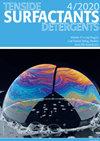由椰油酰胺丙基甜菜碱(CAPB)和十二烷基苯磺酸钠(SDBS)组成的单一表面活性剂和混合表面活性剂在锌表面的吸附情况
IF 1.2
4区 工程技术
Q4 CHEMISTRY, APPLIED
引用次数: 0
摘要
表面活性剂水溶液在金属表面上的吸附特性存在显著差异。本研究评估了表面活性剂混合物在锌金属表面的吸附情况。研究了单一表面活性剂椰油酰胺丙基甜菜碱(CAPB)和十二烷基苯磺酸钠(SDBS)以及它们的混合物在 25 °C、0.00、0.25、0.50、0.75 和 1.00 摩尔分数的水溶液中在锌粉上的吸附情况。在 2% 的锌粉存在和不存在的情况下,测量了单一表面活性剂和 CAPB/SDBS 表面活性剂混合物的表面张力,以确定吸附等温线。吸附研究采用了耗竭法。根据这些表面活性剂在有 2% 锌粉和没有 2% 锌粉时的表面张力与浓度曲线之间的阴影面积,还计算出了表面活性剂的吸附量。结果发现,随着 SDBS 含量的增加,吸附量也随之增加。此外,还拍摄了含有单一或混合 CAPB/SDBS 表面活性剂的溶液中锌薄片在 0.05 M HCl 存在和不存在时的扫描电子显微镜(SEM)图像。显微照片显示,沉淀形成的 CAPB-SDBS 表面活性剂层可以保护锌金属免受酸腐蚀。本文章由计算机程序翻译,如有差异,请以英文原文为准。
Adsorption of single and mixed surfactants consisting of cocoamidopropyl betaine (CAPB) and sodium dodecyl benzene sulfonate (SDBS) onto zinc surface
Aqueous solutions of surfactants exhibit remarkable differences in their adsorption properties on metal surfaces. This study evaluates the adsorption of surfactant mixtures on zinc metal surfaces. The adsorption of single surfactants cocamidopropyl betaine (CAPB) and sodium dodecyl benzenesulfonate (SDBS) and their mixtures from aqueous solution at mole fractions of 0.00, 0.25, 0.50, 0.75 and 1.00 on zinc powder at 25 °C was studied. The surface tension of the single and CAPB/SDBS surfactant mixtures was measured in the presence and absence of 2 % zinc powder to determine the adsorption isotherms. The depletion method was employed to carry out the adsorption investigation. The amount of the surfactant adsorbed was also calculated from the shaded area between the surface tension versus concentration curves of these surfactants in the presence and absence of 2 % zinc powder. The highest adsorbed amounts were found to increase with the SDBS content. Furthermore, scanning electron microscope (SEM) images of zinc sheets in solutions containing single or mixed CAPB/SDBS surfactants were taken in the presence and absence of 0.05 M HCl. The micrographs indicated that the CAPB-SDBS surfactant layers formed by precipitation can protect zinc metal from acid corrosion.
求助全文
通过发布文献求助,成功后即可免费获取论文全文。
去求助
来源期刊

Tenside Surfactants Detergents
工程技术-工程:化工
CiteScore
1.90
自引率
10.00%
发文量
57
审稿时长
3.8 months
期刊介绍:
Tenside Surfactants Detergents offers the most recent results of research and development in all fields of surfactant chemistry, such as: synthesis, analysis, physicochemical properties, new types of surfactants, progress in production processes, application-related problems and environmental behavior. Since 1964 Tenside Surfactants Detergents offers strictly peer-reviewed, high-quality articles by renowned specialists around the world.
 求助内容:
求助内容: 应助结果提醒方式:
应助结果提醒方式:


